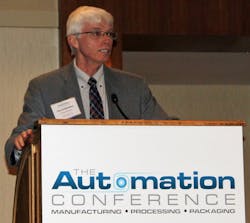When I first spoke with Dean Gary Bertoline of Purdue University about having him deliver a presentation at The Automation Conference 2013, I quickly realized that his topic of choice—a fatal flaw in the U.S. engineering education system—would hit home for a large number of attendees. What I did not realize was how riveted the audience would be with his presentation. (Note: I would like to thank Chuck Edwards, president of Lenze Americas, for connecting me with Dean Bertoline).
Further evidence of the impact of Dean Bertoline’s presentation turned up this week in a blog post by Barry Lynch of GE Intelligent Platforms. Lynch was in attendance at the conference and saw Dean Bertoline’s presentation—as well as the audience’s reaction to it—first hand. With his permission, here’s the post he wrote about the experience:
I recently attended a two-day Automation Conference held in Chicago. I have to say that the one keynote session that drew the most emotion from the attendees, was that of Gary R. Bertoline, Ph.D., Dean of Purdue University.
The session was planned for about 55 minutes but ran at least 30 minutes longer due to the passionate response from those in the room. What Gary was covering was a “fatal flaw” that occurred in 1955 when the U.S. school system decided to focus on academic achievements as opposed to applied engineering and applied computer sciences. As a result, the schools became good at producing good theorists without the technical grounding of practical experience.
As the discussion flowed, many CPG brand manufacturers in the room agreed that today’s problem was getting the right people with the technical background to run the plant, as opposed to graduates with a skillset aimed more at managing the business. You need both, but the balance of experienced applied skills was lacking, and in some cases, not recognized by the manufacturers themselves during the interview process (i.e., Human Resources always favored the degree student to the applied technical student).
As a byline, I started working at 16 years old, under a technical apprentice program at Rolls Royce Aero engines, and undertook part-time college courses that were funded by the company. Sadly, the year after mine was the last one before the apprentice scheme was mothballed. For me, having that engineering background has proven to be valuable time and time again in applying the business value our systems bring, to the practical use to enable this to happen.
So where do we go from here to redress the workforce balance? Well, the consensus of the room was that there needs to be a better accreditation process in place for applied programs, and that’s one thing that Gary is working on. He is asking for manufacturers to reach out to their local colleges to start discussion on how they can be engaged in this transformation.
Personally, I am going to start discussions with the contacts I made from Purdue and Berkeley around collaboration opportunities. Both universities presented keynote speeches and both called out the GE “Industrial Internet” in their presentations as an example of a global company driving manufacturing forward in the 21st century.
What is your perspective, what can we do to help our industry stay globally competitive into the next decade?
Lynch makes a great point about following up on Dean Bertoline’s presentation, i.e., what can we do to change the engineering education system for the better? Feel free to add your comments here or at Lynch’s blog site. You can read additional blog posts by Lynch and others from GE at their Connected World blog site.
One of the projects Automation World undertakes to help promote engineering education is via our Engineering School Innovations website. I’m always on the lookout for new engineering school projects to profile on this site and in the magazine. So please forward any information you have on such projects my way.

